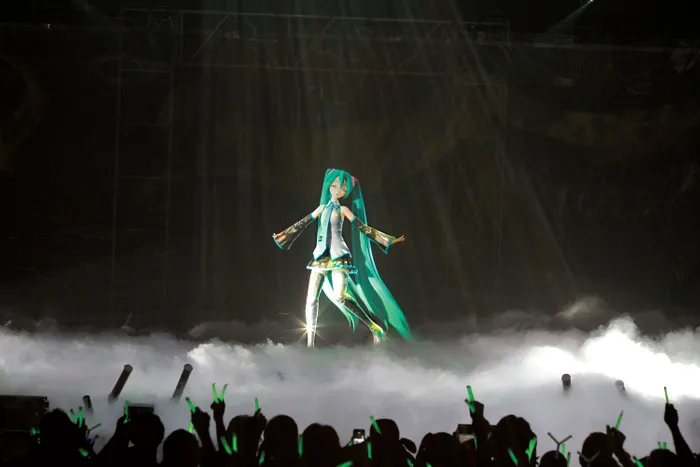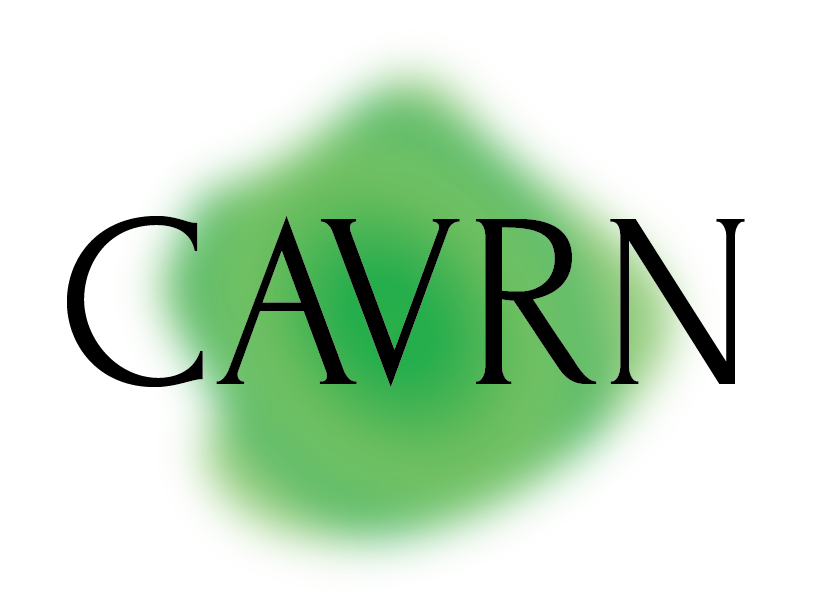Augmentations of control: Posthumanism, producers, and virtual performers

This article is derived from a paper recently published in International Journal of Cultural Studies, titled ‘Girl-instrument: Posthumanism, producers, and virtual performers in Japanese music’. For a more detailed account, you can find the full article here.
The Hyperreal Virtual Performers: Vocaloids
While virtual performers have existed prior to the rise of mixed reality, progressions in augmented reality technologies have allowed such performers to appear on stage in front of live audiences. Perhaps the most famous of these virtual performers are Hatsune Miku and other Vocaloids, which can be distinguished from others by being essentially hyperreal in nature. Proposed by Jean Baudrillard in his foundational post-structuralist work, Simulacra and Simulation, the hyperreal or hyperreality refers to a condition wherein, because of variations in perceptions of reality through and in culture and media, there is a blurred distinction between what is real and what is not real. In the case of Vocaloids, they are hyperreal in the sense that they are performers who release music like any other, despite not being what we might typically think of as ‘real.’ Instead, these entities are unique animated avatars tied to specific voicebanks, used with generative singing software products, that allow virtually anyone to create “a reasonable—if somewhat artificial sounding—facsimile of singing” (Annett, 2015, p. 164) for a few hundred dollars. The avatars of well-known Vocaloids like Miku have not only made their mark in Internet cultures but also perform in-person at concerts as what many erroneously assume to be holograms. In this way, our sense of reality is shifted as the outputs of generative singing software programs are turned into virtual performers in augmented reality.
Because Vocaloids are essentially digital instruments offered at a relatively affordable price of anywhere from forty to two hundred US dollars, they have been acknowledged for offering a form of music creation “where access and participation are potentially unlimited” (Zaborowski, 2016, p. 124). This is especially true as their loose usage agreements allow individuals to freely use these generated vocal tracks, as well as the associated animated avatar, for non-commercial use. There have been various conversations in academia, in popular media, and among fans regarding how Vocaloids, as pseudo-blank slate virtual performers with relatively liberal usage agreements, have transformative possibilities for fostering creative expression (Prior, 2018; Trippett, 2016). More specifically, some suggest that the fluidity of Vocaloids can be used for identity exploration, allowing individuals to explore aspects of nationality (Yin, 2018) or gender and sexuality (March, 2022).
“Vocaloids give us access to freely usable voices and bodies that are often gendered, raising concerns about the kinds of bodies being made available for us by virtually anyone for virtually any purpose.”
However, we can also critique the same freedom that makes Vocaloids unique as such technologies afford us control over disembodied elements of the human body. Vocaloids give us access to freely usable voices and bodies that are often gendered, raising concerns about the kinds of bodies being made available for us by virtually anyone for virtually any purpose. In this way, Vocaloids can potentially contribute to a digital subjugation of femininity that reproduces gender-related issues of agency in both digital technologies and the music industry. It is important then to go beyond the creative affordances of technologies to consider how “VR technologies produce simultaneous effects that are not easily judged to be ‘good’ or ‘bad’” (Balsamo, 1996, p. 132).
Gender and Usage
While there are both male and female-coded Vocaloids, there is a primacy of female Vocaloids—with only four of the top twenty most viewed Vocaloids across YouTube, Nico Nico, and Bilibili, being male (with one of these male characters having a female voice actor). This suggests that the creative explorations that Vocaloids enable are largely practiced through simulacra of the female voice and body. Not only is this a relevant issue in the context of the music industry where female producers are very uncommon (Smith et al, 2023; Lazar et al, 2023; Billboard Japan, 2023), but it is especially complicated within the context of feminized digital technologies—where the female body and voice are often coded to be in a position of servitude (Dawson, 2023; Phan, 2017; Toncic, 2021).
Thus, to consider how the female body, virtualized through Vocaloid technologies, is “transformed into the very medium of cultural expression itself” (Balsamo, 1996, p. 131), we must think about how the female body is used as an instrument of self-expression. While Vocaloids are not humans, they exist as assemblages of parts of humans. Their sound outputs are based on repositories of sound from living, breathing female voice actors and their associated avatars portray two-dimensional versions of young women and girls. Vocaloids are not meant to be representations of humans but rather take parts of the human, separate from the whole, and allow users to manipulate these parts for their own interests. That these Vocaloids are nonhuman in nature makes such manipulations seem ‘harmless.’ However, these tools of creation very often consist of disembodied parts of the female and this particularly gendered slant is worth contemplating. It is therefore important to note that the virtuality of this phenomenon is key in allowing serious ethical issues to be circumvented—especially as the female voice and body are distanced from the human.
“… there is something very unsettling about the practice and consequences of providing the disembodied female voice and body for free use.”
While these manipulations and usages may be harmless in many cases, such control over and usage of the female body can present serious ethical dilemmas. I turn to the freeware program, MikuMikuDance (MMD), as an example. MMD, which allows individuals to use free 3D models of Vocaloids in computer-generated animations, has resulted in individuals using Vocaloid models in music videos and pornography alike.

It is difficult to navigate conversations of consent or ethics here—the models used are freely downloadable, and these Vocaloids do not attempt to portray “real” humans and are ultimately only lines of code. There is technically no rule-breaking occurring here; yet, there is something very unsettling about the practice and consequences of providing the disembodied female voice and body for free use. As easily as individuals can use the disembodied female Vocaloid to create an augmented reality performance where a cyborg female dances and sings for an audience, they can also create pornographic content involving freely manipulable female-coded voices and bodies.
Thus, creation, facilitated by Vocaloid technology, that uses the female as a medium ultimately results in a music-making method where manageable, controllable women are broken into parts, free for anyone to use. This is even more concerning considering that augmented reality virtual performers often are based upon “marginalized racial and gendered others” (McLeod, 2016, p. 510). While some might argue that mixed reality is a type of escape from the ‘real world,’ this assertion is not fitting at a moment in time when modern technologies “decrease the ability to easily escape the virtual” (Conner, 2016, p. 143). Put simply, we cannot escape from the virtual when it is so closely intertwined with the real in our day-to-day lives. These considerations do not seek to refute positive readings of Vocaloids nor the possibilities they might have for creation. Instead, this article hopes to assert that these positive possibilities may have more insidious effects as individuals participate in exercises of control over the female body.
References
Annett S (2015). What Can a Vocaloid Do? The Kyara as Body Without Organs. Mechademia 10: 163–79. https://doi.org/10.5749/mech.10.2015.0163
Balsamo AM (1996) Technologies of the Gendered Body: Reading Cyborg Women. Durham: Duke University Press.
Baudrillard J (2001) Simulacra and Simulations. In: Jean Baudrillard: Selected Writings. Stanford University Press, pp. 169–187.
Billboard Japan (2023) Billboard Japan: Women in Music. Available at: https://www.billboard-japan.com/wim/ (accessed 1 June 2024).
Conner T (2016) Hatsune Miku, 2.0Pac, and Beyond: Rewinding and Fast-Forwarding the Virtual Pop Star. In: Whiteley S and Rambarran S (eds) The Oxford Handbook of Music and Virtuality. Oxford University Press.
Dawson K (2023) Solving women’s voices? A theoretical framework for talking through the algorithm. Communication and the Public 8(4): 266–275. https://doi.org/10.1177/20570473231187188
Lazar E, Appleton B, Smyth M, et al. (2023) Lost in the mix: An analysis of credited technical professionals in the music industry highlighting women and non-binary producers and engineers across DSP playlists, genres, awards, record certifications & distributors. Fix the Mix Annual Report. Fix the Mix Initiative. Available at: https://www.mtsu.edu/media/fix.pdf (accessed 1 June 2024).
March L (2022) “Wrap You Up in My Blue Hair”: Vocaloid, Hyperpop, and Identity in “Ashnikko Feat. Hatsune Miku – Daisy 2.0”. Television & New Media: 1–17. https://doi.org/10.1177/15274764221093599
McLeod K (2016) Living in the Immaterial World: Holograms and Spirituality in Recent Popular Music. Popular Music and Society 39(5): 501–515. https://doi.org/10.1080/03007766.2015.1065624
Phan T (2017) The materiality of the digital and the gendered voice of Siri. Transformations (29): 24. http://www.transformationsjournal.org/wp-content/uploads/2017/02/Transformations29_Phan.pdf
Prior N (2018) On vocal assemblages: From Edison to Miku. Contemporary Music Review 37(5-6): 488–506. https://doi.org/10.1080/07494467.2017.1402467
Smith SL, Pieper K, Hernandez K, et al. (2023) Inclusion in the recording studio: gender & race/ethnicity of artists, songwriters & producers across 1,100 popular songs from 2012 to 2022. USC Annenberg Inclusion Initiative, University of California-Annenberg. Available at: https://assets.uscannenberg.org/docs/aii-inclusion-recording-studio-jan2023.pdf (accessed 1 June 2024).
Toncic J (2021) I Dream of Siri: Magic and female voice assistants. Catalyst: Feminism, Theory, Technoscience 7(2): 2. https://doi.org/10.28968/cftt.v7i2.34906
Trippet D (2019) Digital voices: Posthumanism and the generation of empathy. In: Ingall’s MM and Cook N (eds) The Cambridge Companion to Music in Digital Culture. Cambridge: Cambridge University Press, pp. 227–248.
Yin Y (2018). Vocaloid in China: Cosmopolitan music, cultural expression, and multilayer identity. Global Media and China, 3(1): 51–66. https://doi.org/10.1177/2059436418778600
Zaborowski R (2016) Hatsune Miku and Japanese Virtual Idols. In: Whiteley S and Rambarran S (eds) The Oxford Handbook of Music and Virtuality. Oxford University Press.
Recommended citation
Ng Man Chuen, C. (September, 2024). Augmentations of control: Posthumanism, producers, and virtual performers. Critical Augmented and Virtual Reality Researchers Network (CAVRN). https://cavrn.org/augmentations-of-control-posthumanism-producers-and-virtual-performers/
This work is licensed under a Creative Commons Attribution-NonCommercial-NoDerivatives 4.0 International License.
